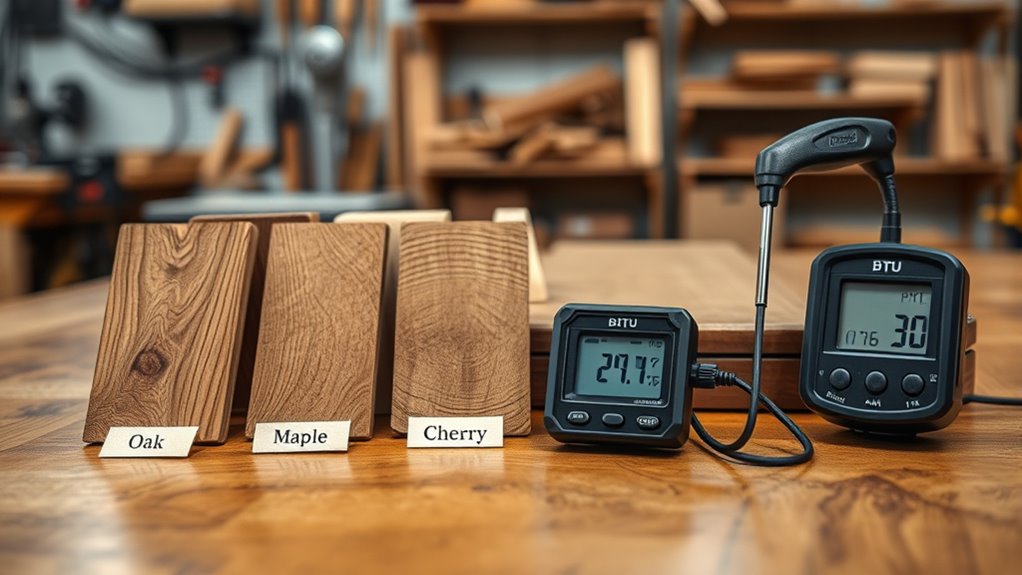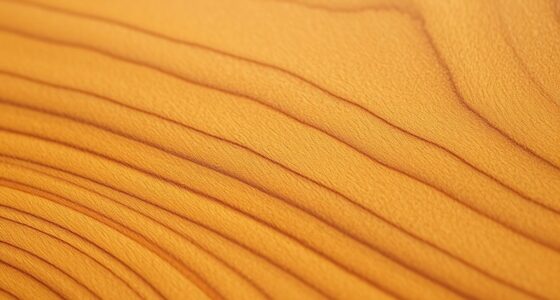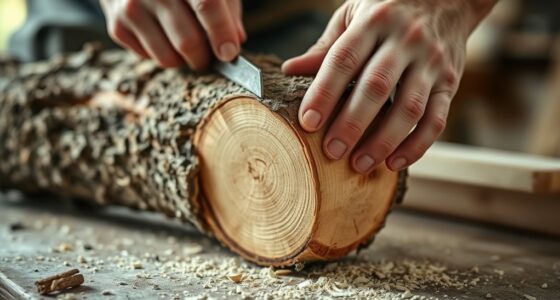To measure BTU output by wood species, you can use standardized testing methods like calorimetry, which quantifies the heat released during combustion. Reputable sources often provide pre-tested BTU values, and you can also perform controlled tests using proper sample preparation. Keep in mind that factors like moisture content and wood density influence BTU ratings. If you want to understand how different woods compare and how to optimize your firewood, there’s more to explore.
Key Takeaways
- Use standardized testing methods like ASTM E711 to measure the heat energy released during combustion of specific wood samples.
- Consult reputable sources or pre-tested data for BTU ratings of different wood species to ensure accuracy.
- Properly prepare wood samples by controlling moisture content and density before testing for consistent results.
- Calorimetry is the most precise technique to determine BTU output for various wood types under controlled conditions.
- Comparing BTU ratings across species helps select high-energy woods like oak or hickory for efficient heating.
Understanding BTU Measurements for Firewood
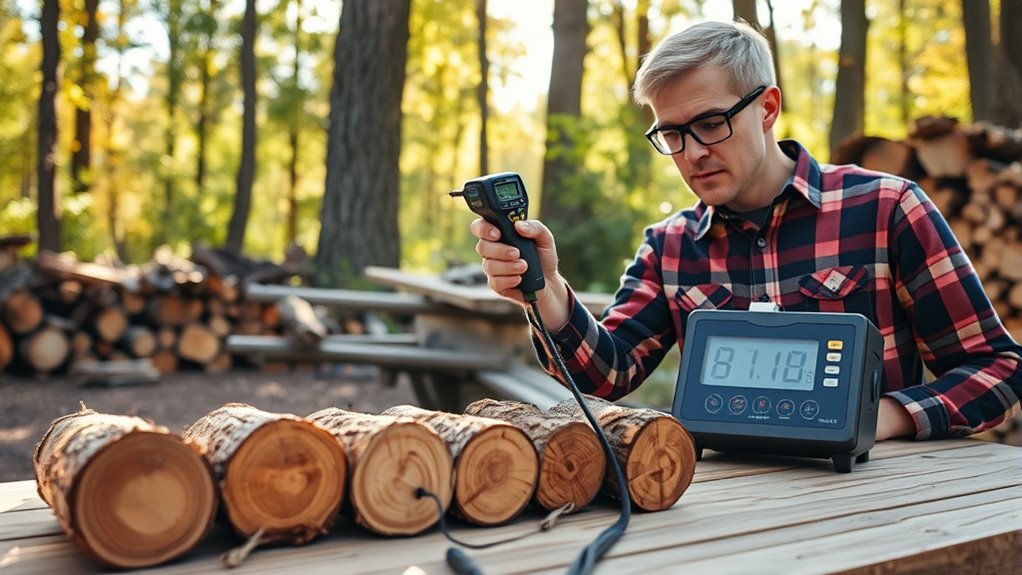
Understanding BTU measurements for firewood is essential because it helps you determine how much heat a piece of wood can produce when burned. BTU, or British Thermal Unit, quantifies the energy needed to raise one pound of water by one degree Fahrenheit. When you burn firewood, the BTU rating indicates the amount of heat released during combustion. Different types of wood contain varying amounts of energy, influenced by moisture content and density. Moisture content significantly affects the BTU output, as wetter wood produces less heat and more smoke. Knowing the BTU value helps you choose the right wood for your heating needs, ensuring efficient and effective warmth. It also allows you to compare different species and make informed decisions about your firewood purchases. Additionally, proper storage of firewood helps maintain its BTU potential by preventing moisture absorption. Ultimately, understanding BTU measurements helps you maximize heat output while managing resources wisely. Accurate BTU ratings are essential for selecting the most effective firewood for your heating system.
Factors Influencing BTU Output in Different Species

Several factors influence the BTU output of different wood species, with moisture content being one of the most significant. When wood is wetter, it contains more water that must evaporate before the wood burns efficiently, reducing heat output. Hardness also plays a role; denser woods like oak or hickory typically produce higher BTUs because they contain more combustible material per volume. The wood’s resin and sap content can boost heat value, as these substances burn hotter. Additionally, the age and density of the wood affect combustion efficiency. Younger, less dense wood burns faster but generates fewer BTUs overall. Understanding these factors helps you select the best wood for maximum heat, ensuring you get the most energy from your firewood regardless of species. Moisture content is particularly critical, as improperly seasoned wood can significantly reduce BTU output. AI detection methods continue to evolve, helping identify authentic wood sources and prevent fraudulent practices in the industry. Moreover, advancements in wood grading and certification contribute to more reliable assessments of wood quality and heat output. Recognizing the influence of technology can further improve the accuracy of BTU measurements and quality assurance.
Methods for Testing and Calculating BTU Values

To accurately determine the BTU output of different wood species, you need reliable testing methods that measure the heat energy released during combustion. One common approach is calorimetry, where a sample is burned in a controlled environment, and the heat produced is measured using a calorimeter. This method provides precise BTU values by capturing the total energy released. Another technique involves using standardized laboratory tests, such as the ASTM E711 method, which ensures consistency across different samples and studies. Additionally, researchers often rely on published data from reputable sources that have already performed these tests under controlled conditions. Proper sample preparation, controlled combustion conditions, and precise measurement tools are essential for accuracy. These methods form the foundation for reliable BTU calculations, especially when considering factors like air quality benefits that can influence combustion efficiency. Incorporating testing protocols and standardized procedures helps ensure the consistency and reliability of BTU measurements across various wood species. Moreover, understanding the regional variations in wood density and moisture content can further refine BTU estimations for specific locations. In some cases, advanced analytical techniques can also be employed to improve measurement precision and account for variables like moisture content and density.
Comparing BTU Ratings Among Common Wood Types

When comparing BTU ratings among common wood types, it’s important to recognize that not all woods produce the same amount of heat energy. Hardwoods like oak, hickory, and maple generally have higher BTU values because they contain denser fibers, releasing more heat when burned. Softwoods such as pine and cedar tend to have lower BTU ratings due to their lower density and moisture content. Keep in mind that the moisture level considerably impacts heat output; seasoned wood with less than 20% moisture burns more efficiently. Additionally, regional variations and wood quality can influence BTU ratings. Understanding wood density and moisture content can also help in selecting the best wood for your heating needs, ensuring maximum heat output and efficient use of your firewood. Properly storing firewood can also help maintain optimal moisture levels and improve burning efficiency. Being aware of firewood storage methods can further enhance combustion performance and heat output.
Tips for Maximizing Heat Efficiency Based on BTU Data
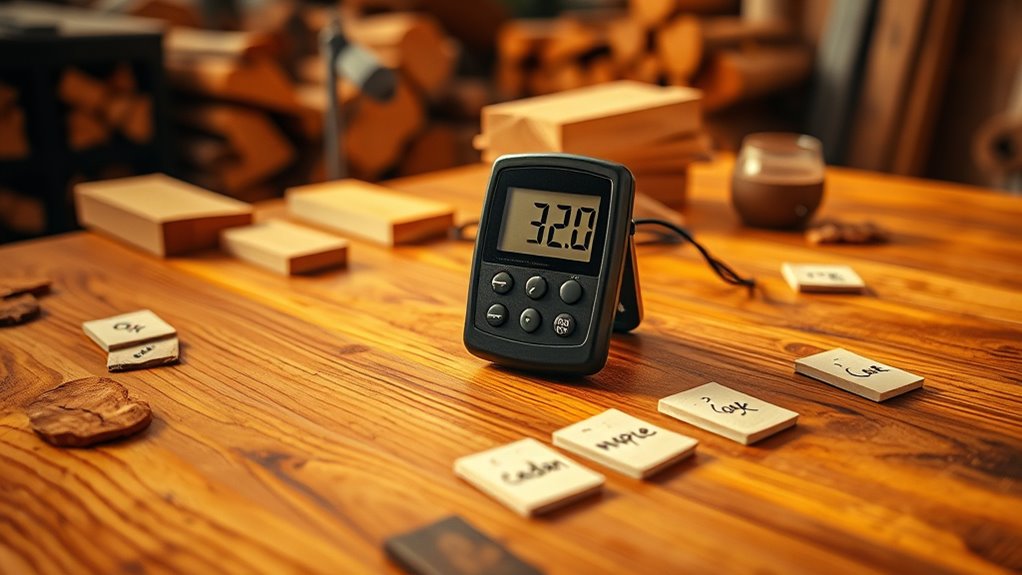
Maximizing heat efficiency starts with choosing the right wood and preparing it properly. Select high-BTU species like oak or hickory for more heat output. Make sure your wood is seasoned—dried for at least 6-12 months—to reduce moisture content, which improves combustion and heat transfer. Store wood in a dry, well-ventilated area off the ground. When loading your stove or fireplace, arrange the wood to promote good airflow, allowing complete burning. Use proper sizing—split logs increase surface area for faster, more efficient burning. Regularly clean your chimney and stove to prevent creosote buildup, which hampers efficiency. Proper firewood storage also helps maintain the wood’s quality and moisture level. By following these tips based on BTU data, you’ll maximize heat output, save fuel, and keep your home warmer more efficiently.
Frequently Asked Questions
How Does Moisture Content Affect BTU Output in Various Woods?
Moisture content directly impacts the BTU output of wood. When your wood has high moisture, it burns less efficiently, producing fewer BTUs because energy goes into evaporating water. As you dry your wood, its moisture content drops, increasing its energy efficiency and BTU output. To get the most heat, you should use well-seasoned wood with low moisture levels, ideally below 20%.
Are There Regional Differences in Wood Species’ BTU Ratings?
You’ll find regional differences in wood species’ BTU ratings because certain woods are more common in specific areas. For example, hardwoods like oak and hickory have higher BTU values and are plentiful in some regions, while softer woods like pine are more common elsewhere. Local climate, forest types, and logging practices influence which woods you can burn, affecting their energy output and efficiency for heating.
Can Mixed Wood Loads Impact Overall BTU Efficiency?
Mixing different wood species can impact your overall BTU efficiency. When you combine high and low BTU woods, you may experience inconsistent heat output, uneven burning, and reduced energy efficiency. You might find that the lower BTU wood drags down the performance of the higher BTU species, leading to suboptimal combustion and more frequent refueling. To maximize heat, stick to similar wood types or understand how each contributes to your heating goals.
How Does Wood Age Influence Its BTU Value?
You might wonder how wood aging affects its BTU value. As wood ages, it can lose moisture, making it burn more efficiently and release more heat. However, over time, it might also degrade or develop mold, which can reduce its energy output. Generally, well-aged, properly stored wood tends to have a higher BTU value because it’s drier and burns cleaner, giving you better heating performance.
What Are the Environmental Implications of Choosing High BTU Woods?
When you choose high BTU woods, you’re impacting the environment in several ways. These woods often come from faster-growing or less sustainable sources, which can lead to deforestation and habitat loss. Additionally, burning high BTU woods may emit more pollutants if not properly dried or processed. To minimize your environmental footprint, select sustainably harvested woods and verify they’re well-seasoned to reduce emissions during burning.
Conclusion
Remember, knowing the BTU output of different wood species helps you make smarter choices for heat. By understanding each type’s energy content, you can burn efficiently and stay warm all winter. Think of it like selecting the right fuel for your fire—because as the saying goes, “A little knowledge is a dangerous thing,” but in this case, it’s the key to a cozy home. Use this info wisely, and your fire will burn brighter and longer.
